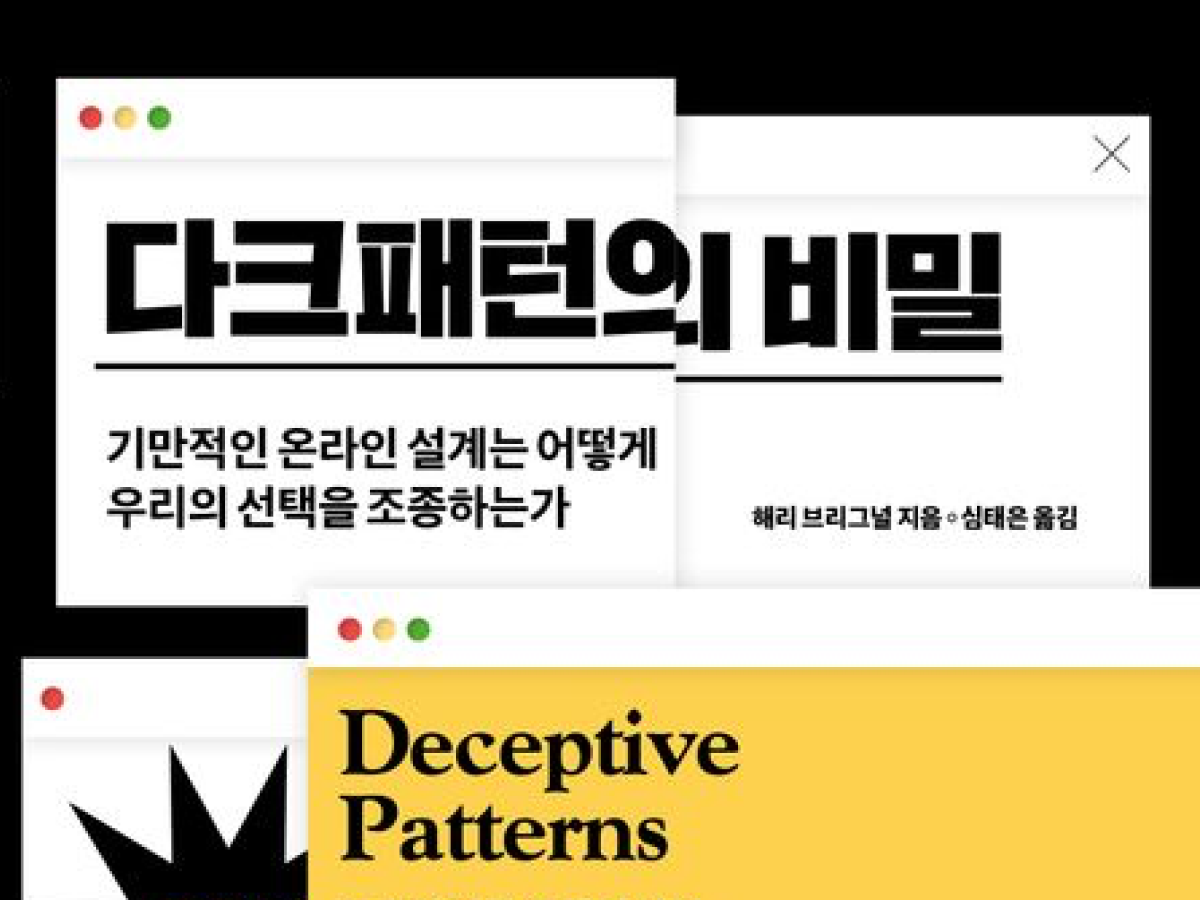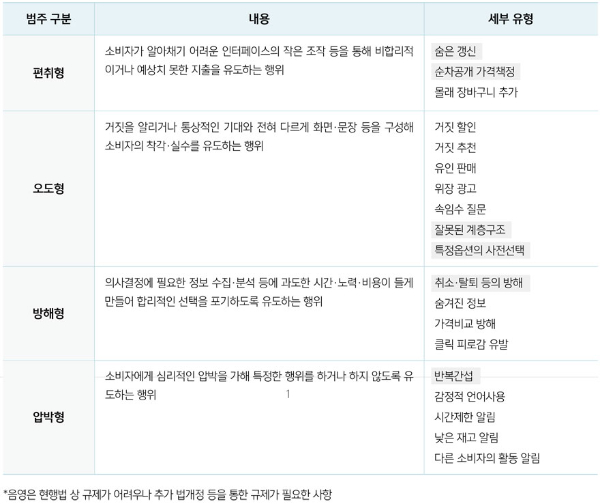

Dark Pattern (Dark pattern: deceptive design)
😇 Some people have been asking me to cover dark patterns, as Psychology 101, which I'll be using someday, has gone viral. As 2023 approaches, there are growing calls to regulate these dark patterns, and guidelines have been released. I hope you find them helpful in your design, marketing, and planning efforts.
4 Principles to Prevent Dark Patterns
•
Help users make their own decisions.
•
Don't deliberately make users give up.
•
Provide complete, unbiased information.
•
Don't pressure the user.
230731(참고) 온라인 다크패턴 자율관리 가이드라인 제정.pdf239.97KB
230421(참고) (별첨) 온라인 다크패턴으로부터 소비자 보호를 위한 정책방향.pdf3.64MB
As noted by the Fair Trade Commission, the need for regulation is being discussed. Among these, please pay special attention to the seven types currently prohibited by law:
(false discounts, false recommendations, bait sales, disguised advertising, trick questions, hidden information, and obstruction of price comparison).
(false discounts, false recommendations, bait sales, disguised advertising, trick questions, hidden information, and obstruction of price comparison).

Definition of Dark Pattern by the Fair Trade Commission
•
Inducing consumers to spend irrationally or unexpectedly
•
Inducing consumers to make mistakes or be misled by providing false information or composing screens/sentences in a way that's completely different from usual expectations
•
Requiring excessive time and effort to collect and analyze information needed for decision-making
•
Applying psychological pressure on consumers to make them act or refrain from acting in certain ways
Predatory type (2 types of behavior)
① Hidden Renewal: Automatically renewing a contract and processing payment without notifying the consumer when a service switches from free to paid, or when charges are increased
(Example) Sneaking products the consumer didn’t select into the shopping cart to get them to pay for it
② Sequential Price Disclosure: Luring consumers by showing only part of the total price that must be paid on the first screen, hiding or omitting the rest of the payment without a valid reason (limited scope)
Misleading type (7 types of behavior)
③ Fake Discount: Misleading consumers into paying more by falsely advertising discounts
④ Fake Recommendation: Deleting negative reviews or writing fake positive reviews
⑤ Bait-and-Switch: Luring consumers by advertising "bait products" that aren’t actually for sale as if they were available
⑥ Disguised Advertising: Presenting ads to consumers as though they're just regular content, not advertisements
⑦ Trick Questions: When suggesting options to consumers, intentionally making the content or wording needlessly complicated or ambiguous, so the consumer may misunderstand and have trouble making a rational decision
⑧ Incorrect Hierarchy: When offering choices for product purchase, registration, or contract cancellation, making visual distinctions (size, shape, color, etc.) between options so the consumer may wrongly think the items are not equal, or that a certain item is a required condition (limited scope)
⑨ Pre-Selecting Certain Options: During checkout, the business presents an option to buy an additional product, but pre-selects that option to encourage the purchase (limited scope)
Obstructive type (3 types of behavior)
Making cancellation, termination, or withdrawal processes more complicated than purchase or sign-up, or limiting the ways to cancel, so consumers can't freely cancel, terminate, or withdraw
(Example) If steps to cancel, terminate, or withdraw are much more complicated and require more steps than purchase or sign-up
⑩ Hidden Information: Luring or transacting with consumers by concealing, reducing, or omitting important details needed to decide on a purchase
(Example) Advertising "Free studio family photo shoot" but only providing one not-so-great photo out of 50 for free, charging extra for viewing, printing, or sending digital files of the better photos
⑪ Inducing Click Fatigue: Making the cancellation, termination, or withdrawal process needlessly harder than purchase, registration, etc., or limiting the ways to cancel, so consumers can't easily cancel or withdraw (limited scope)
⑫ Obstructing Price Comparison: Luring or transacting with consumers by showing prices using different sizes, quantities, or bundle units among similar products for no valid reason, to make it hard to compare prices and by concealing or leaving out this fact (limited scope)
Pressure type (5 types of behaviors)
⑬ Repeated Interruption: Pressuring users into specific actions by repeatedly asking through pop-ups, etc.
⑭ Using Emotional Language: Pressuring users to act certain ways using emotionally charged language
⑮ Time-Limited Notification: Pressuring consumers to make a decision by showing that discounts are available only within a certain time frame
⑯ Out-of-Stock/High Demand Notification: Pressuring consumers by notifying them there's no stock or high demand
⑰ Showing Other Consumers' Activity: Pressuring decision-making by displaying the number of people who have recently viewed or bought this product

https://uxknowledgebase.com/dark-patterns-3b41ed7a690e


